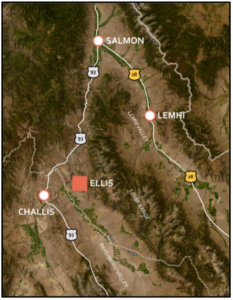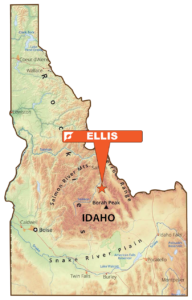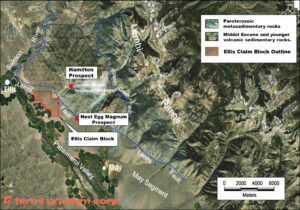Lemhi County
Idaho
Highlights
- Fermi has 52 unpatented mining claims totaling 1,070 acres in a uranium-bearing tertiary basin.
- Uranium occurs as basal-type occurrences in channel-filling deposits of carbonaceous and mudstone.
- The target area is 100% Bureau of Land Management supervised ground.
- Regional historic drilling indicated the presence of uranium roll-front occurrences.
- The geology of the area is conducive to roll-front uranium deposits. Extraction via in-situ recovery methods would be cost effective.

Location & History
The Ellis Project is situated in Lemhi County, Idaho, 16 miles northeast of the town of Challis and 42 miles southwest of Salmon, Idaho. The project consists of 52 Federal unpatented lode mining claims totaling approximately 1,070 acres. The geology of the Ellis Project has not been mapped in detail, but is situated in the western pediment of the Lemhi Mountains, a high-relief range in central Idaho.
The original uranium exploration boom of the 1950’s brought exploration to the uranium-thorium veins in Custer County, and alkalic complexes in eastern Lemhi County. By 1971, roll-front type uranium deposits were being developed in Wyoming, and interest in uranium deposits moved toward central Idaho. According to Howland’s 1973 report, the only reference available, the Union Pacific Uranium Prospect located 40 miles southwest of the Ellis Project and drilled by Union Pacific Minerals, generated considerable interest in the region. By 1978, Exxon had staked the Ellis Prospect claims over what is now the Ellis uranium project. All exploration and drilling are historical and are only described in Howland’s 1973 report.
The Ellis Prospect area is known by several uranium-bearing prospects: one located directly above the Ellis townsite to the east; another, called the Hamilton Prospect, is located to the east; and a southern prospect about 0.75 miles southwest of the Hamilton, which is known as the Nest-Egg Magnum prospect. See photo, below:
Geology & Mineralization
The three most important aspects of the local geology are:
- The underlying Tertiary-age structure of the northern Pahsimeroi Valley
The Pahsimeroi Valley is comprised of unconsolidated fluvial and alluvial deposits shed from the adjacent mountains, glacial deposits, and overbank river deposits. Beneath the permeable Quaternary valley are Tertiary sedimentary rocks, 50-million-year-old Challis volcanic rocks, Paleozoic sedimentary rocks, and Precambrian metasedimentary rocks. - The uranium endowment of the Challis volcanic rocks
The Challis volcanics are potash-rich, cal-alkaline rocks and in general, are not known to be enriched in uranium. However, numerous highly differentiated silicic intrusions that acted in part as feeders to the enclosing phases of Challis volcanism are rich in uranium and thorium. These intrusions range from rhyolite to granite, and from plugs, domes, dikes, and stocks to batholiths. - The Quarternary alluvial development in the Valley from west-draining topography of the Lemhi Range
The unconformity at the previously-mentioned Quarternary alluvium/bedrock contact is the targeted formation for uranium mineralization on the Ellis Project, with the Challis Volcanics being the source rock.
Property
Fermi Uranium Corp. maintains 52 unpatented mining claims for the Ellis Project:
- Ellis Claims (52)
| Claim Name | BLM Serial # | Date of Location |
|---|---|---|
| ELLIS 1 | ||
| ELLIS 2 | ||
| ELLIS 3 | ||
| ELLIS 4 | ||
| ELLIS 5 | ||
| ELLIS 6 | ||
| ELLIS 7 | ||
| ELLIS 8 | ||
| ELLIS 9 | ||
| ELLIS 10 | ||
| ELLIS 11 | ||
| ELLIS 12 | ||
| ELLIS 13 | ||
| ELLIS 14 | ||
| ELLIS 15 | ||
| ELLIS 16 | ||
| ELLIS 17 | ||
| ELLIS 18 | ||
| ELLIS 19 | ||
| ELLIS 20 | ||
| ELLIS 21 | ||
| ELLIS 22 | ||
| ELLIS 23 | 7/14/22 | ID105781708 |
| ELLIS 24 | 7/14/22 | ID105781709 |
| ELLIS 25 | 7/14/22 | ID105781710 |
| ELLIS 26 | 7/14/22 | ID105781711 |
| ELLIS 27 | 7/14/22 | ID105781712 |
| ELLIS 28 | 7/14/22 | ID105781713 |
| ELLIS 29 | 7/14/22 | ID105781714 |
| ELLIS 30 | 7/14/22 | ID105781715 |
| ELLIS 31 | 7/14/22 | ID105781716 |
| ELLIS 32 | 7/14/22 | ID105781717 |
| ELLIS 33 | 7/14/22 | ID105781718 |
| ELLIS 34 | 7/14/22 | ID105781719 |
| ELLIS 35 | 7/14/22 | ID105781720 |
| ELLIS 36 | 7/14/22 | ID105781721 |
| ELLIS 37 | 7/14/22 | ID105781722 |
| ELLIS 38 | 7/14/22 | ID105781723 |
| ELLIS 39 | 7/14/22 | ID105781724 |
| ELLIS 40 | 7/14/22 | ID105781725 |
| ELLIS 41 | 7/14/22 | ID105781726 |
| ELLIS 42 | 7/14/22 | ID105781727 |
| ELLIS 43 | 7/14/22 | ID105781728 |
| ELLIS 44 | 7/14/22 | ID105781729 |
| ELLIS 45 | 7/14/22 | ID105781730 |
| ELLIS 46 | 7/14/22 | ID105781731 |
| ELLIS 47 | 7/14/22 | ID105781732 |
| ELLIS 48 | 7/14/22 | ID105781733 |
| ELLIS 49 | 7/14/22 | ID105781734 |
| ELLIS 50 | 7/14/22 | ID105781735 |
| ELLIS 51 | 7/14/22 | ID105781736 |
| ELLIS 52 | 7/14/22 | ID105781737 |

